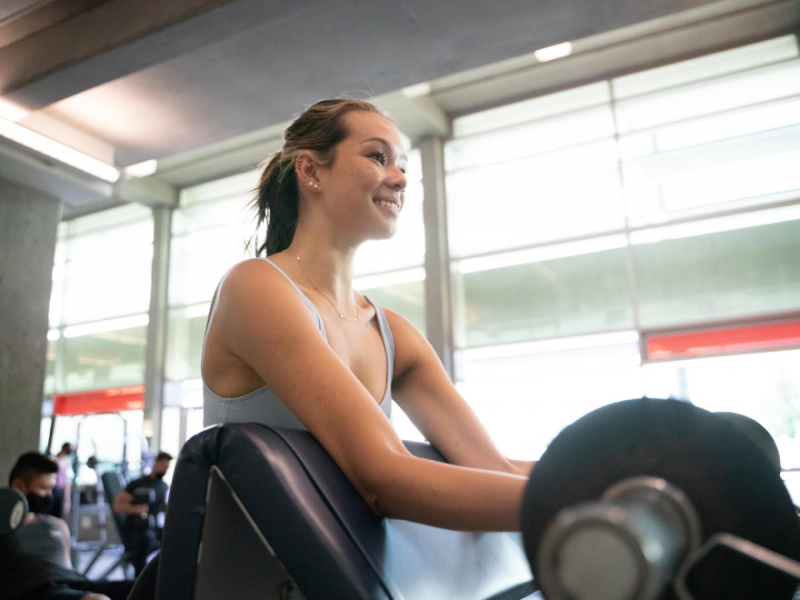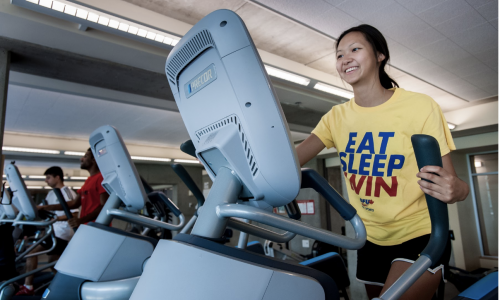
This blog was originally posted on the SFU Recreation website on August 10th, 2021.
Hours and hours of screen time can take a toll on our bodies. Recently, a 24-hour movement guideline was created by a mix of different organizations and scientists to help optimize our physical health through increasing physical activities throughout the day, limiting sedentary time to under 8 hours a day, and aiming for 7-9 hours of sleep every day. Following the guidelines will help you lower your risk of various chronic diseases and help you maintain positive mental health. One thing you can do is set up a home workout to get you motivated and make adding physical activity to your life that much easier.
Although the casual and relaxing environment of our home may not seem like the optimal place for us to workout in, home workouts have a couple of edges over fitness studios, such as:
-
Time saving. Being able to work at home, allows you to skip the time commuting to a gym and avoid waiting for equipment.
-
Low cost. Home gyms can be costly, but there are lots of low-budget alternatives and objects in your house that can be easily substituted for workout equipment. This in turn can save you from the hefty membership bills every month.
-
Flexibility. With our gym being at home, we can easily insert multiple small workouts throughout our day. This also provides more flexibility for when we want to work out and for how long. Thus, making increasing physical activity and decreasing sedentary behaviors easier.
Try out some of our tips to help you get set up:
Step one of working out is getting into the right mindset. It is not just about the exercises that you are doing, but the environment that surrounds you. It is important to be comfortable as well as motivated! Here are a couple of factors to consider when getting ready to work out:
-
Wearing the right workout clothes. Don't feel like you need to get a whole new wardrobe. Find comfortable clothes that help you get into the workout mindset and do not restrict your movements.
-
Listen to your body. Rest is very important. If your body is not feeling it that day, then take a break. When you are starting out, it is important that you slowly build up your stamina before increasing intensity and frequency of workouts.
-
Have fun with it! Doing something you like will make it easier to keep you going and stay motivated.
-
Create an appropriate workout playlist. Curate a playlist of songs that are of a certain beats per minute (BPM), or tempo, that matches your workout type. For regular cardio-based workouts, consider songs that are 120-140 BPM.
Creating a designated workout space can help you get into the mindset and make you look forward to working out. Here are some tips for setting up your space:
-
Personalize your space. If possible, put up some motivational posters or decorate to help with the atmosphere. Make the space somewhere you want to spend time in and that helps get your body in the exercise mindset. Try to also keep it a workout only space if possible.
-
Take advantage of natural lighting. Spaces with windows or areas with nice lighting makes your body more awake. Our bodies work on a light/dark cycle so we tend to workout harder under bright natural lights.
-
Declutter your space. When you're working out it can be easy to get distracted. Try to minimize the distractions and only bring out workout equipment when it's needed. This will also give you more space to move around.
-
Invest in workout mats. If you live in an apartment, mats can help insulate the sounds from your workout and make for happier neighbors. If your floor is a hard surface, workout mats will help protect your floor and prevent injuries by cushioning your joints.
-
Make sure your space is ventilated. With summer around the corner, you are going to want to make sure that you don't overheat. Try to pick a space with windows and/or invest in fans.
Home workouts can be hard to start, since there's no equipment to help guide you through it. However, there are lots of body weight exercises and some substitute equipment that you can use:
-
Makeshift free weights. To substitute those expensive dumbbells, you can always fill up milk jugs and bottles with water to your desired weight. You can also take advantage of textbooks or fill up an empty backpack with things lying around in your home.
-
Chairs and stairs. Chairs and stairs can help bring variety to your workouts and increase or decrease the difficulty of exercises. For example, seated exercises can increase stability, while standing exercises activates core muscles. Chairs and stairs can also be used to do inclined exercises and for a variety of cardio exercises, such as step-ups, jumps, and more.
-
Walls. Walls can be great for doing full body workouts. It's free and easily accessible. They also provide a strong flat surface that can be used to help correct muscle imbalances and help with balance.
-
Yoga mats or carpet. Yoga mats help reduce the pressure on your back when you lay on hard floors and allow you to perform various yoga and core exercises on a cushioned surface. If yoga mats are not easily accessible, a spacious carpet area can be used as an alternative.
With the weather starting to get better, working out outside is a great alternative to the gym. As well, not everyone has as much space inside their house as they would like. Being outside can provide more space, as well as fresh air and a new change of scenery.
-
Take your workout outside. There are lots of workouts that you can do in your backyard with no equipment or using the things around you like monkey bars in playgrounds.
-
Go for a run or walk. Explore your local neighborhood and parks by planning new routes. This can help add some excitement and cardio into your workout and allow you to learn more about the area near your home. Check out our previous blog for tips on how to get started running.
-
Play some outdoor sports. Throw a football around or practice running routes. You can work on basic drills for your sport, or even try a new sport on your own or with someone in your bubble.
Home gyms can be as intricate or simple as you want. Whatever fits your needs and fitness goals is the right way. There are also a range of free and accessible resources available to help you with planning your workout, such as:
-
Check out SFU's Healthy at Home Initiative. SFU offers free live and recorded classes at beginner to advanced level.
-
Follow @sfurecreation on Facebook, Instagram, and Twitter. SFU Recreation staff members post tips related to active living.
-
Try an app. There are a lot of free apps containing workouts and fitness trackers to keep you motivated and track your progress. Browse your phone app store.
It's important to make sure that whatever you do, your home workout space works for you and keeps you motivated and excited to work out.














